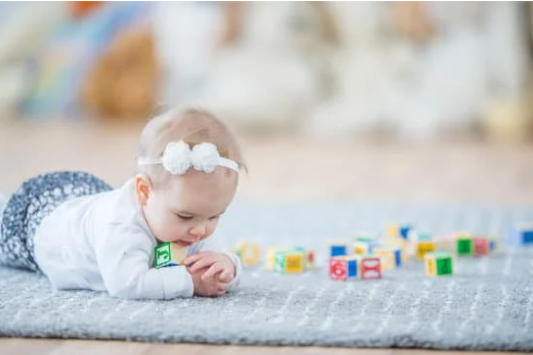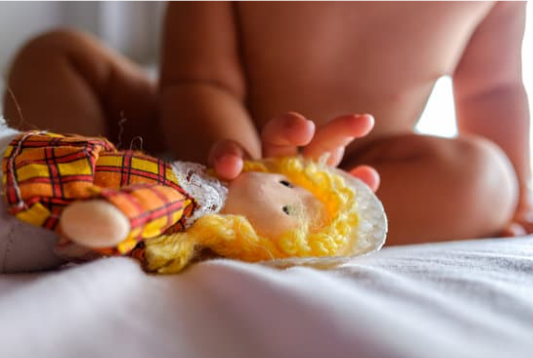Have you ever noticed how little ones always want to touch everything in sight, and even put items in their mouths? That’s because the sense of touch is one of the best ways for them to learn!
I have put together the ultimate guide to the touch sense PLUS toy and activity suggestions!
What is Sensory Touch / The Touch Sense?
Touch (or tactile) receptors are all over our skin. We have neural receptors in our skin, some places have more than others.
The touch sense is comprised of lots of different types of stimuli such as pressure, pain, different textures and temperatures, vibrational movement, etc.
What do we know about skin and how it relates to the touch sense?
Fun fact: did you know that the largest organ in the body is skin?
Not only does our skin protect and keep our internal organs contained, our skin processes touch and sends information to the brain about:
Pain
Pain signals are received and communicated to the spinal cord through nerves. When the threat of pain is perceived we are prompted into a fight or flight response.
Temperature
Temperature is an interesting one because too hot or cold would be associated with a pain type of response discussed above. Interestingly enough, there are more receptors for cold than there is for hot!
Touch
Everything you feel involves the touch sense. When something touches your skin, it produces a response. Some individuals are more sensitive to touch than others.
Vibration
Vibration is felt through the skin, muscles and bones depending on how fast/vigorously the vibration is.
So what does our touch sense help us do?
- Feel
- Sense hot/cold
- Use motor skills with precision
- Move away if something is painful (like a hot pan, or pulling away from a thorn)
Related Post: Sensory Play for Babies
What are the different types of touch?
Protective Touch
Protective touch helps to keep us safe. This type of touch sets off a warning system within our bodies when something brushes up against the skin.
When we feel a light touch, it makes us pull away from the perceived danger. For me, I do not like bugs. So if I feel a light scratchy or tickley touch, I will probably think it’s a bug LOL.
Discrimitive Touch
This type of touch sends detailed information about what you touched and where the touch was located on your body. Things like hot, cold, wet and sticky are the things that is communicated.
Deep Touch Pressure
This type of touch is like getting a hug or wearing a weighted blanket. The receptors tell where you being touched and how much pressure you are feeling.
How do we know if our touch sense isn’t working?
Slow Responses to sensory touch:
- May not cry when injured
- Doesn’t react to being bumped
- Seems to not notice dirty hands or face
Seeks out Sensory Touch
- Doesn’t know when to stop touching
- Touches a variety of objects or textures all the time
- Likes Hair being touched or brushed/cut
Sensitivity to Touch
- Hates having hair cut/brushed
- Does not touch things often
- Particular about textures avoids trying new foods or clothing
Related Post: 7 Benefits of Sensory Bins
Is our Touch Sense Important for Learning?
Yes! The touch sense is essential in your child’s development because so much learning happens by tough. The brain receives information from what your child is touching which in turn, helps your child learn about their environment.
Can I help my child develop touch sense?
Yes, you can help your child develop the touch sense! If you are looking for some ideas, tips and tricks keep scrolling!
Activities to help develop your child’s touch sense:
0-6 Months old Touch Sense Activities
Babies touch sense is active even inside the womb! Stimulating the touch sense in the early months is vital for development.

- Baby Massage
- Grasping different textured and sized objects
- Snuggling
- Bath time
- Tummy time on a play mat
Blurb 1 image and then list of activities (for each)
6-9 Months Old Touch Sense Activities
At 6-9 months old, babies are quickly developing, and learning every second of the day. They are starting to form opinions about textures that they do and don’t like.

- Exploring texture books
- Playing with noise maker toys
- Playing in different textures like Greek yogurt and rice cereal
- Playing with bubbles
0-12 Months Touch Sense Activities
Touch sense activities can be fun and practical activities to do with babies of all ages. The activities can be simple and easy to more complex and intricate.

- Taste different foods with different textures
- Painting with the hands
- Playing in shaving cream
- Playing in playdough
- Feeling different temperature items
1-2 Year Old Touch Sense Activities
Sensory activities with toddlers can be so fun! Watching their eyes fill with wonder as they learn and experience new things is so amazing.

- Playing with noodles of different shapes and sizes
- Playing in a water table or kiddie pool
- Squishing slime
- Making and playing with sensory bottles
- Play in kinetic sand
3-4 Year Old Touch Sense Activities
Sense of touch activities are great for preschool age children is wonderful for their development in respect to fine motor skills.

- Create a simple sensory bin with rice and other objects that you have around the house.
- Create sensory bottles
- Play with playdough and use tools like the cookie cutters, play knife, etc.
- Play in the mud
- Make and play with oobleck, find the recipe here
Related Post: Sensory Board DIY For Babies & Toddlers
Toys to help Develop Your Child’s Touch Sense
Toys can be a valuable tool in helping to develop your child’s touch sense. Using toys as an activity helps to stimulate your child’s touch sense and allows them to have fun in the process!

These sensory balls are great way to have your little one feel different textures. They are also great to take with you in the diaper bag because they don’t take up a ton of room.
Little Chubby One: Textured Mini Pillows

This is a relaxing and calming activity for kids, these textured squares encourage children to engage in hands-on, tactile play, helping them to develop social and emotional interactions.

By touching and stepping on piano play mat, improves baby’s touch sense at early age. Enable your child’s development, their brain power, memory, confidence, patience, social skills and creativity!

Sensory bean bags toy makes the perfect game time for babies. These sensory toys give babies the chance to use their motor skills and burn off their energy and keeping them busy for a long time!

The sensory tissue box provides the ultimate sensory activity that promotes the development of fine motor skills in your child. Pull textured scarves out of a plush tissue box and discover exciting colors and textures
This toy helps to develop coordination, exploration and color recognition, improve hand-eye coordination, dexterity, and fine motor skills as you explore the sense of touch with these textured scarves
Fun Facts about touch
- Our Touch sensitivity develops faster in the left hand than the right!
- Newborn baby girls are more sensitive to touch than boys
- Females have a better sense of touch
- Our finger prints help send signals to our nerves and also rule out unimportant vibrations
The touch sense is extremely important to your child’s development. Helping your child to develop their sense of touch will only better the touch sense!
What are your favorite touch sense activities and toys? Let me know in the comments below!


